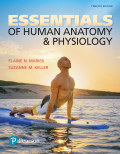
EBK ESSENTIALS OF HUMAN ANATOMY & PHYSI
12th Edition
ISBN: 8220103633604
Author: KELLER
Publisher: PEARSON
expand_more
expand_more
format_list_bulleted
Concept explainers
Question
Chapter 8, Problem 30SAE
Summary Introduction
To review:
The name provided to the taste receptors.
Introduction:
Taste buds consist of cells that are basically taste receptors and these cells are known as gustatory cells. The receptors are situated around the small structures that are known as papillae and these are found on the upper layer of tongue, oesophagus, soft palate, epiglottis, and cheeks.
Expert Solution & Answer
Want to see the full answer?
Check out a sample textbook solution
Students have asked these similar questions
Please draw in the missing answer, thank you
Please fill in all blank questions, Thank you
please fill in missing parts , thank you
Chapter 8 Solutions
EBK ESSENTIALS OF HUMAN ANATOMY & PHYSI
Ch. 8 - Prob. 1MCCh. 8 - Alkaloids excite gustatory hairs mostly at the a....Ch. 8 - Prob. 3MCCh. 8 - Which cranial nerve controls contraction of the...Ch. 8 - The cornea is nourished by a. corneal blood...Ch. 8 - When the eye focuses for far vision, a. the lens...Ch. 8 - Convergence a. requires contraction of the medial...Ch. 8 - 8. Which of the following are paired...Ch. 8 - Movement of the ______ membrane triggers bending...Ch. 8 - 10. Sounds entering the external acoustic meatus...
Ch. 8 - Prob. 11SAECh. 8 - Prob. 12SAECh. 8 - 13. Diagram and label the internal structures of...Ch. 8 - Prob. 14SAECh. 8 - Prob. 15SAECh. 8 - 16. What is the blind spot, and why is it so...Ch. 8 - What name is given to the structure that controls...Ch. 8 - What is the fovea centralis, and why is it...Ch. 8 - 19. Trace the pathway of light from the time it...Ch. 8 - Prob. 20SAECh. 8 - 21. Define hyperopia, myopia, and emmetropia.
Ch. 8 - Prob. 22SAECh. 8 - Prob. 23SAECh. 8 - Prob. 24SAECh. 8 - Many students struggling through mountains of...Ch. 8 - Prob. 26SAECh. 8 - Prob. 27SAECh. 8 - Prob. 28SAECh. 8 - Prob. 29SAECh. 8 - Prob. 30SAECh. 8 - Prob. 31SAECh. 8 - Prob. 32SAECh. 8 - Prob. 33SAECh. 8 - Which special sense requires the most learning?Ch. 8 - 35. For each of the following descriptions,...Ch. 8 - An engineering student has been working in...Ch. 8 - Prob. 37CTCh. 8 - Prob. 38CTCh. 8 - Brandon suffered a ruptured artery in his middle...Ch. 8 - Prob. 40CTCh. 8 - Prob. 41CTCh. 8 - 42. Julie and her father love to find the...Ch. 8 - Prob. 43CTCh. 8 - 44. Mrs. Garson has an immune disorder that causes...Ch. 8 - Prob. 45CTCh. 8 - Explain the role of vitamin A in vision.
Knowledge Booster
Learn more about
Need a deep-dive on the concept behind this application? Look no further. Learn more about this topic, biology and related others by exploring similar questions and additional content below.Similar questions
- please draw in the answers, thank youarrow_forwarda. On this first grid, assume that the DNA and RNA templates are read left to right. DNA DNA mRNA codon tRNA anticodon polypeptide _strand strand C с A T G A U G C A TRP b. Now do this AGAIN assuming that the DNA and RNA templates are read right to left. DNA DNA strand strand C mRNA codon tRNA anticodon polypeptide 0 A T G A U G с A TRParrow_forwardplease answer all question below with the following answer choice, thank you!arrow_forward
- please draw in the answeres, thank youarrow_forwardA) What is being shown here?B) What is indicated by the RED arrow?C) What is indicated by the BLUE arrow?arrow_forwardPlease identify the curve shown below. What does this curve represent? Please identify A, B, C, D, and E (the orange oval). What is occurring in these regions?arrow_forward
- Please identify the test shown here. 1) What is the test? 2) What does the test indicate? How is it performed? What is CX? 3) Why might the test be performed in a clinical setting? GEN CZ CX CPZ PTZ CACarrow_forwardDetermine how much ATP would a cell produce when using fermentation of a 50 mM glucose solution?arrow_forwardDetermine how much ATP would a cell produce when using aerobic respiration of a 7 mM glucose solution?arrow_forward
- Determine how much ATP would a cell produce when using aerobic respiration to degrade one small protein molecule into 12 molecules of malic acid, how many ATP would that cell make? Malic acid is an intermediate in the Krebs cycle. Assume there is no other carbon source and no acetyl-CoA.arrow_forwardIdentify each of the major endocrine glandsarrow_forwardCome up with a few questions and answers for umbrella species, keystone species, redunant species, and aquatic keystone speciesarrow_forward
arrow_back_ios
SEE MORE QUESTIONS
arrow_forward_ios
Recommended textbooks for you
 Human Biology (MindTap Course List)BiologyISBN:9781305112100Author:Cecie Starr, Beverly McMillanPublisher:Cengage Learning
Human Biology (MindTap Course List)BiologyISBN:9781305112100Author:Cecie Starr, Beverly McMillanPublisher:Cengage Learning Principles Of Radiographic Imaging: An Art And A ...Health & NutritionISBN:9781337711067Author:Richard R. Carlton, Arlene M. Adler, Vesna BalacPublisher:Cengage Learning
Principles Of Radiographic Imaging: An Art And A ...Health & NutritionISBN:9781337711067Author:Richard R. Carlton, Arlene M. Adler, Vesna BalacPublisher:Cengage Learning
 Human Physiology: From Cells to Systems (MindTap ...BiologyISBN:9781285866932Author:Lauralee SherwoodPublisher:Cengage Learning
Human Physiology: From Cells to Systems (MindTap ...BiologyISBN:9781285866932Author:Lauralee SherwoodPublisher:Cengage Learning

Human Biology (MindTap Course List)
Biology
ISBN:9781305112100
Author:Cecie Starr, Beverly McMillan
Publisher:Cengage Learning

Principles Of Radiographic Imaging: An Art And A ...
Health & Nutrition
ISBN:9781337711067
Author:Richard R. Carlton, Arlene M. Adler, Vesna Balac
Publisher:Cengage Learning




Human Physiology: From Cells to Systems (MindTap ...
Biology
ISBN:9781285866932
Author:Lauralee Sherwood
Publisher:Cengage Learning
The Sensorimotor System and Human Reflexes; Author: Professor Dave Explains;https://www.youtube.com/watch?v=M0PEXquyhA4;License: Standard youtube license